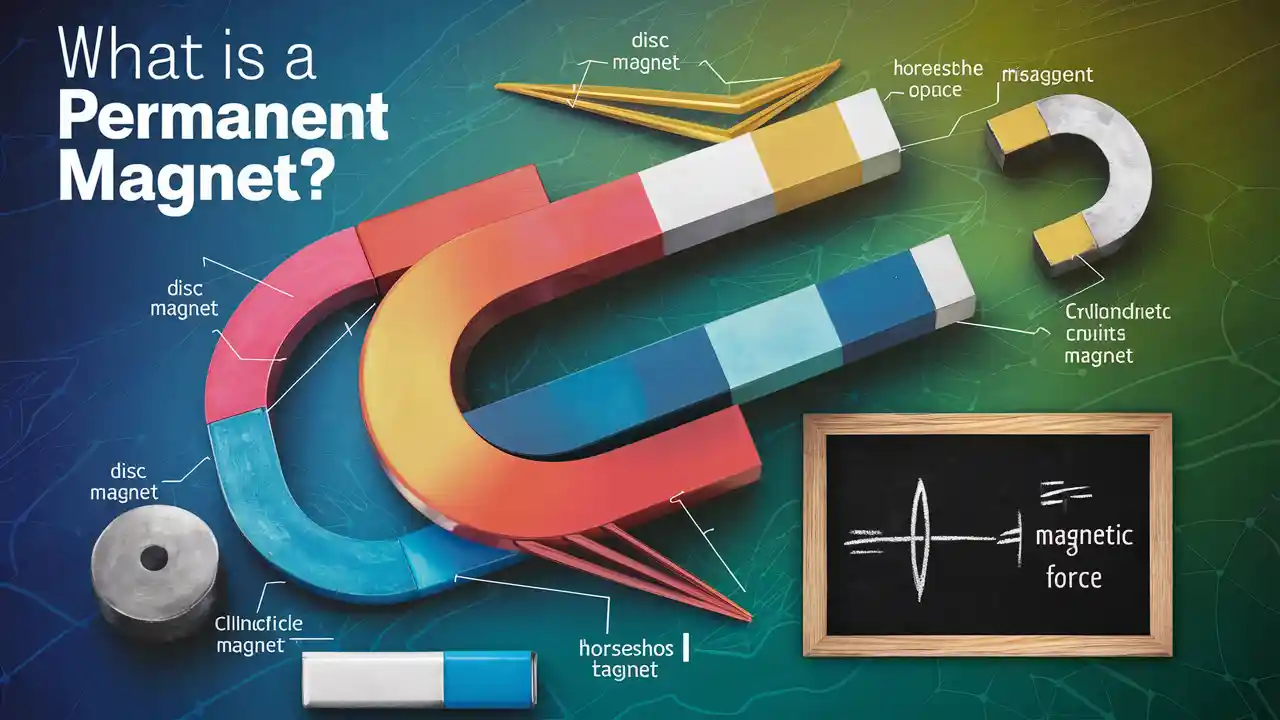Ever wonder why that fridge magnet sticks year after year without batteries? Or how your earbuds produce crisp sound from invisible forces? Here’s the deal: permanent magnets make modern life possible—and they’re way more fascinating than you think.
Let me explain…
A permanent magnet is a material that generates its own persistent magnetic field without needing electricity. Unlike temporary magnets (like electromagnets), these bad boys stay magnetized indefinitely under normal conditions. Pretty cool, right?
As a professional neodymium magnet manufacturer, I will share everything you need to know about permanent magnets in this post.

What is a Permanent Magnet
A permanent magnet is a material that produces its own persistent magnetic field without the need for an external electric current or inducing field. Unlike electromagnets, which only exhibit magnetism when electricity flows through them, permanent magnets remain magnetized indefinitely under normal conditions.
How Permanent Magnets Actually Work
Here’s the deal: Magnetism starts at the atomic level. Inside atoms, electrons spin like tiny tops—creating mini magnetic fields.
But here’s the kicker:
In most materials, these spins point in random directions, canceling each other out. No net magnetism.
But in ferromagnetic materials? Game changer.
Materials like iron, nickel, and cobalt form “magnetic domains”—groups of atoms whose spins align in the same direction. Think of these as microscopic magnets with their own north and south poles.
To create a permanent magnet, manufacturers expose the material to a powerful external magnetic field (often while heating and cooling it). This forces most domains to align in one direction.
Pro Tip: Once the external field disappears, “hard” ferromagnetic materials lock that alignment in place. That’s the secret sauce.
The 3 Non-Negotiable Properties
What makes these magnets truly permanent? Three rockstar properties:
- Remanence (B_r): Measures residual magnetic strength after removal of the magnetizing field. Higher B_r = stronger magnet. Neodymium magnets? Off-the-charts remanence.
- Coercivity (H_c): Resistance to demagnetization. Think of it as the magnet’s “immune system” against opposing fields. Alnico magnets? Surprisingly low coercivity.
- Curie Temperature (T_c): The heat threshold where magnetism vanishes. Exceed this, and your magnet becomes a paperweight. Ferrite magnets handle heat well; neodymium? Not so much.
| Property | Why It Matters | Real-World Impact |
|---|---|---|
| Remanence (B_r) | Determines magnetic strength | Stronger motors, smaller speakers |
| Coercivity (H_c) | Prevents demagnetization | Reliability in vibrating environments |
| Curie Temp (T_c) | Defines thermal limits | Stability in engine compartments, industrial gear |
5 Types of Permanent Magnets
Not all permanent magnets are created equal. Let’s break them down:
1. Rare-Earth Magnets (The Powerhouses)
- Neodymium (NdFeB): Strongest commercial magnets. Energy products up to 52 MGOe! But sensitive to heat (loses strength >80°C) and corrosion. Found in Tesla motors and MRI machines.
- Samarium Cobalt (SmCo): Handles temperatures up to 300°C. Perfect for aerospace sensors and precision instruments.
Fun Fact: A neodymium magnet the size of a quarter can lift over 20 pounds. Seriously.
2. Ferrite Magnets (The Budget Warriors)
- Made from iron oxide + barium/strontium compounds
- Cheap, corrosion-resistant, but weaker magnetic field
- You’ll find these in speakers, refrigerator seals, and magnetic separators
3. Alnico Magnets (Old-School Reliability)
- Aluminum + Nickel + Cobalt alloys
- Withstand temps up to 550°C! Perfect for guitar pickups and sensors
- Downside? Brittle and lower energy density
4. Flexible Magnets (The Shape-Shifters)
- Ferrite powder in rubber/plastic binders
- Weak magnetism but cuttable into custom shapes
- Think: car door seals and promotional fridge magnets
5. Nanocomposites (The Future)
- Materials like Nd₂Fe₁₄B blended with iron compounds
- Experimental now, but promise stronger fields in smaller sizes
- Potential game-changer for medical implants and micro-robotics
Permanent Magnets in Your Daily Life (You’ll Be Shocked)
Sound surprising? Permanent magnets are everywhere:
- Your Car: 70+ magnets in alternators, power windows, and EV motors (up to 2kg of neodymium per electric vehicle!)
- Tech Gear: Smartphone vibration motors, laptop hard drives, wireless chargers
- Medical Miracles: MRI machines use superconducting magnets generating fields 60,000x Earth’s magnetism
- Green Energy: Wind turbines use ~700kg of magnets per megawatt capacity
Case Study: Toyota Prius motors contain about 1kg of neodymium. By 2025, demand for EV magnets will triple—reaching 45,000 tons annually.
Permanent Magnets vs. Electromagnets: The Ultimate Showdown
How do they stack up? Here’s the lowdown:
| Feature | Permanent Magnets | Electromagnets |
|---|---|---|
| Power Requirement | Zero external power needed | Requires continuous electricity |
| Magnetic Field | Constant, unadjustable | Adjustable strength (on/off possible) |
| Applications | Speakers, fridge magnets, motors | MRI machines, junkyard cranes, relays |
| Temperature Limits | Varies by material (Curie temp critical) | Limited only by wire insulation |
| Cost Efficiency | Higher upfront, zero operating cost | Lower upfront, continuous energy cost |
But here’s the thing: Hybrid systems often use both. Your hybrid car? Permanent magnets in the motor, electromagnets in regenerative braking.



